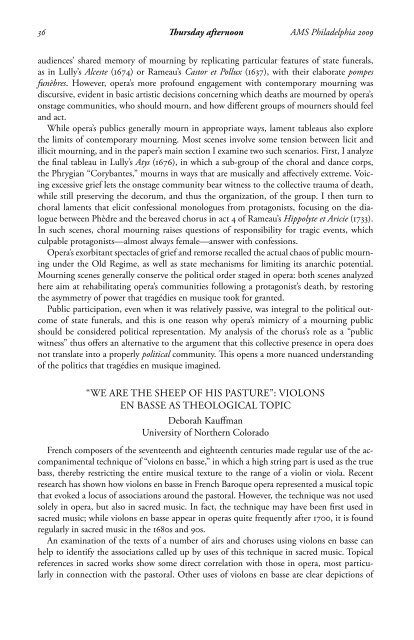AMS Philadelphia 2009 Abstracts - American Musicological Society
AMS Philadelphia 2009 Abstracts - American Musicological Society
AMS Philadelphia 2009 Abstracts - American Musicological Society
Create successful ePaper yourself
Turn your PDF publications into a flip-book with our unique Google optimized e-Paper software.
36 Thursday afternoon <strong>AMS</strong> <strong>Philadelphia</strong> <strong>2009</strong><br />
audiences’ shared memory of mourning by replicating particular features of state funerals,<br />
as in Lully’s Alceste (1674) or Rameau’s Castor et Pollux (1637), with their elaborate pompes<br />
funèbres. However, opera’s more profound engagement with contemporary mourning was<br />
discursive, evident in basic artistic decisions concerning which deaths are mourned by opera’s<br />
onstage communities, who should mourn, and how different groups of mourners should feel<br />
and act.<br />
While opera’s publics generally mourn in appropriate ways, lament tableaus also explore<br />
the limits of contemporary mourning. Most scenes involve some tension between licit and<br />
illicit mourning, and in the paper’s main section I examine two such scenarios. First, I analyze<br />
the final tableau in Lully’s Atys (1676), in which a sub-group of the choral and dance corps,<br />
the Phrygian “Corybantes,” mourns in ways that are musically and affectively extreme. Voicing<br />
excessive grief lets the onstage community bear witness to the collective trauma of death,<br />
while still preserving the decorum, and thus the organization, of the group. I then turn to<br />
choral laments that elicit confessional monologues from protagonists, focusing on the dialogue<br />
between Phèdre and the bereaved chorus in act 4 of Rameau’s Hippolyte et Aricie (1733).<br />
In such scenes, choral mourning raises questions of responsibility for tragic events, which<br />
culpable protagonists—almost always female—answer with confessions.<br />
Opera’s exorbitant spectacles of grief and remorse recalled the actual chaos of public mourning<br />
under the Old Regime, as well as state mechanisms for limiting its anarchic potential.<br />
Mourning scenes generally conserve the political order staged in opera: both scenes analyzed<br />
here aim at rehabilitating opera’s communities following a protagonist’s death, by restoring<br />
the asymmetry of power that tragédies en musique took for granted.<br />
Public participation, even when it was relatively passive, was integral to the political outcome<br />
of state funerals, and this is one reason why opera’s mimicry of a mourning public<br />
should be considered political representation. My analysis of the chorus’s role as a “public<br />
witness” thus offers an alternative to the argument that this collective presence in opera does<br />
not translate into a properly political community. This opens a more nuanced understanding<br />
of the politics that tragédies en musique imagined.<br />
“WE ARE THE SHEEP OF HIS PASTURE”: VIOLONS<br />
EN BASSE AS THEOLOGICAL TOPIC<br />
Deborah Kauffman<br />
University of Northern Colorado<br />
French composers of the seventeenth and eighteenth centuries made regular use of the accompanimental<br />
technique of “violons en basse,” in which a high string part is used as the true<br />
bass, thereby restricting the entire musical texture to the range of a violin or viola. Recent<br />
research has shown how violons en basse in French Baroque opera represented a musical topic<br />
that evoked a locus of associations around the pastoral. However, the technique was not used<br />
solely in opera, but also in sacred music. In fact, the technique may have been first used in<br />
sacred music; while violons en basse appear in operas quite frequently after 1700, it is found<br />
regularly in sacred music in the 1680s and 90s.<br />
An examination of the texts of a number of airs and choruses using violons en basse can<br />
help to identify the associations called up by uses of this technique in sacred music. Topical<br />
references in sacred works show some direct correlation with those in opera, most particularly<br />
in connection with the pastoral. Other uses of violons en basse are clear depictions of










